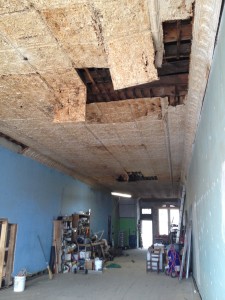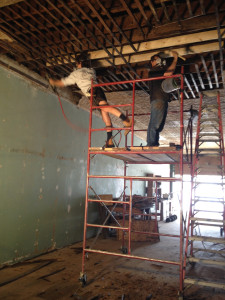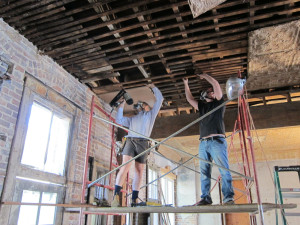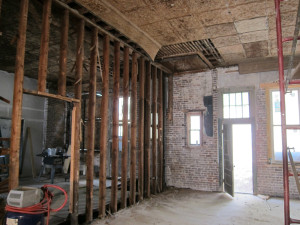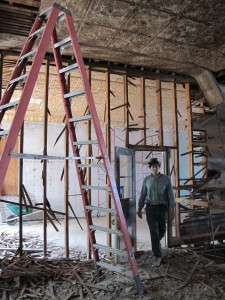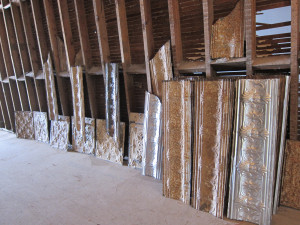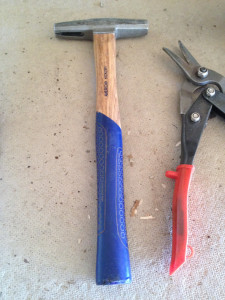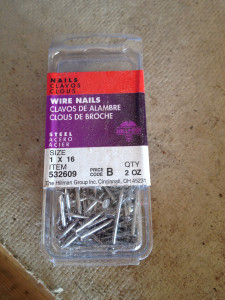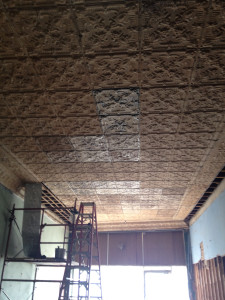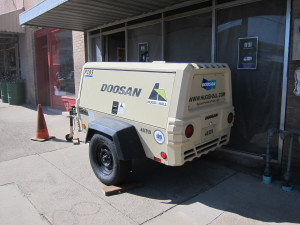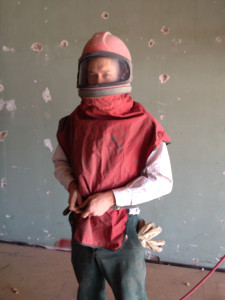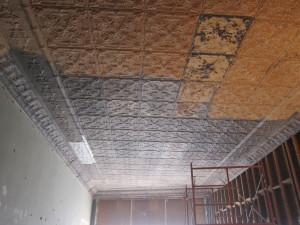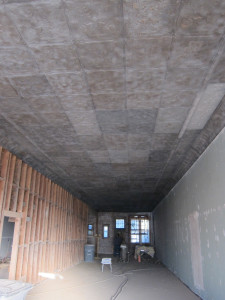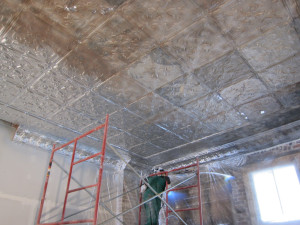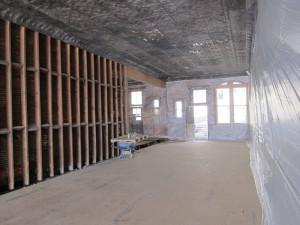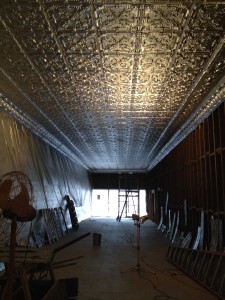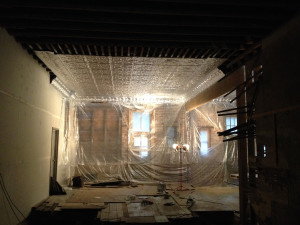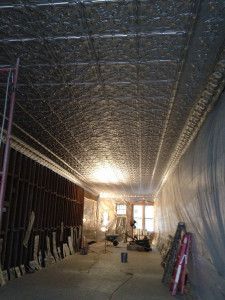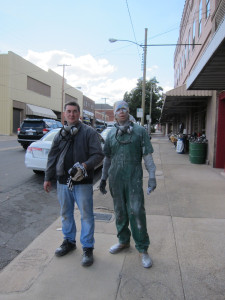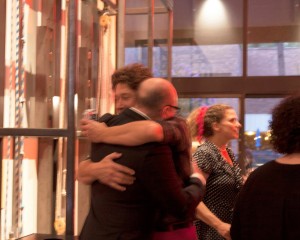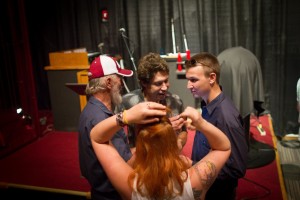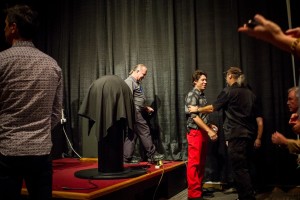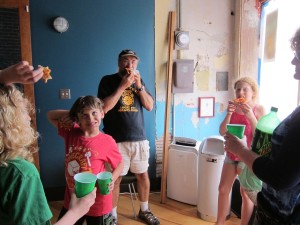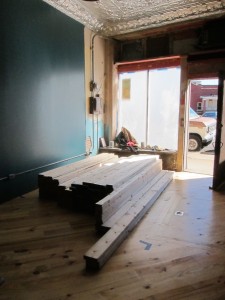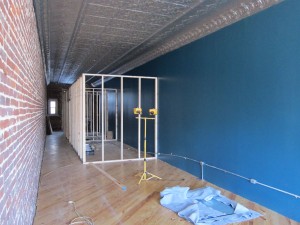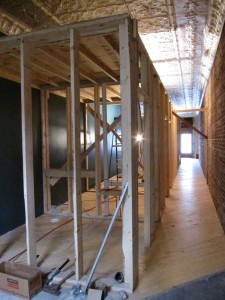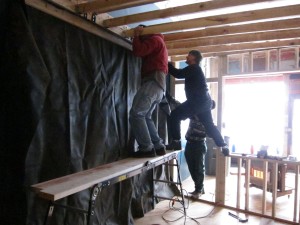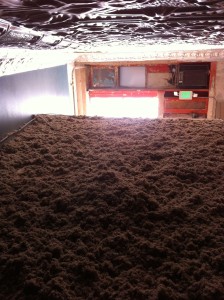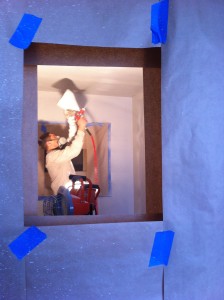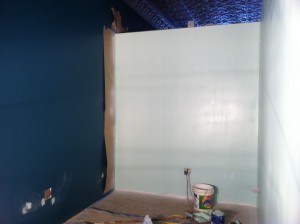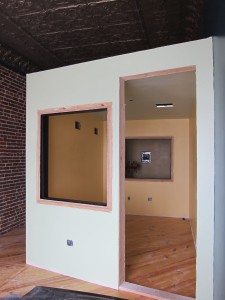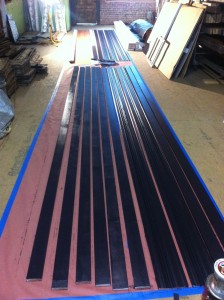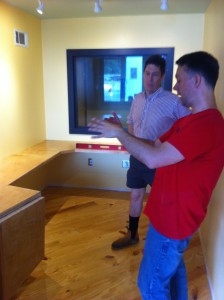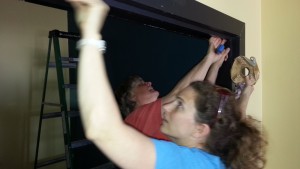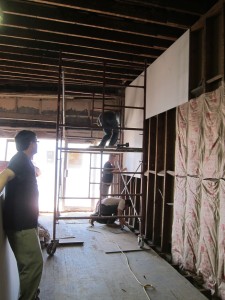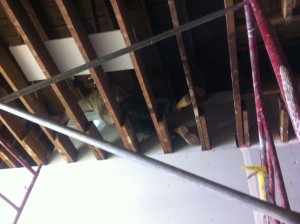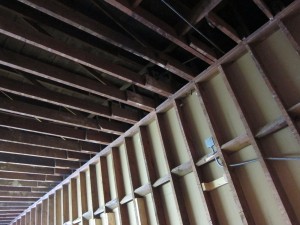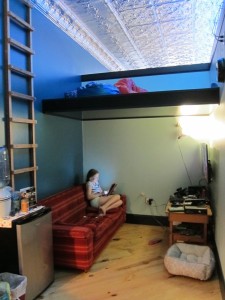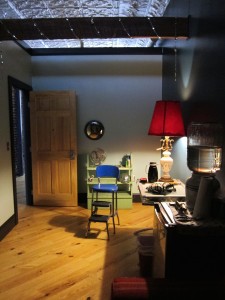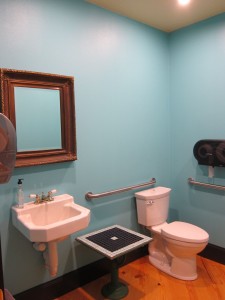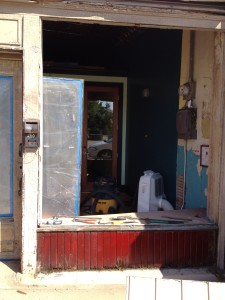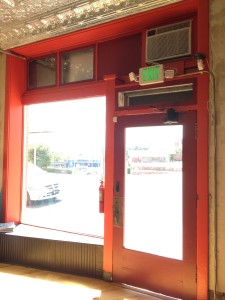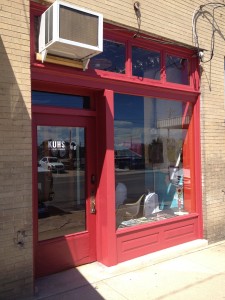You finish the tin ceiling, and as pretty and as majestic as it looks, it only makes the other things look worse. Not that one wouldn’t notice the room with half wood floor half dirt with a precarious ramp built by a hillbilly taking you to the other sea of wood flooring. The next project was getting that room a floor. Simple, right? You see concrete floors all the time! You just call the guy, and the truck comes, and then your pretty much done. Sounds good to me.
Well, actually, lets go ahead and do all the demo work. Okay. So Robbie, Zac, and I cut up the remainder of the wood floor and haul it to the dump. To say it wasn’t salvageable is the understatement of the year. So that nastiness is gone, and we are left with a very strange pattern of old pipes coming out of every which way, and the old drainage pipe junction.
We did a bunch of demo work, busted out old concrete, got out all the crazy pipes going everywhere, and leveled it out as best we could. Then we brought in 20 tons of fill and wheelbarrowed it in. Then 20 more tons. Then 20 more tons. Holy cow, that room was hungry. But this brought it up to right where it needed to be by our humble estimations. Having 20 tons of gravel dumped on the street is a very funny thing to do. You might think you’d need a permit, or to get permission, but you don’t need a permit, and what you get is admiration. People just couldn’t believe you’d bring that in with a wheelbarrow! After all the nasty work we had done, a wheelbarrow was a pretty simple, straightforward tool. It was better than hammering in one inch nails above your head. Our neighbor John, of Monty’s Pawn Shop would come over every now and then and do a couple loads. There was even a guy who drove by, parked, had his own wheelbarrow and shovel in the back of his truck, ran across the street with his tools and moved the gravel with us for a few hours! Matthew was his name. Looked familiar, didn’t really know him. The gravel pile. I’m telling you, if you ever get lonely, get a gravel pile, dump it on a city street and just start moving it around. You’ll meet all sorts of people. Make sure you look like you know what you are doing, and make sure it is gone by sundown and you sweep up. That is apparently the rules for giant gravel piles on city streets in Hot Springs.
This room is going to get all the plumbing in it. We had hired a plumber, who gave us a very reasonable bid, who had been hired to the radio station side. He was fine. He was really a residential plumber, but we all liked each other fine and it seemed like a go. As Zac was trying to hone in the details on the plumbing job, we realized our residential plumber didn’t really seem to know much about grease traps. He didn’t really seem to know much about what we were doing at all. Drainage under the sidewalk. Sprinkler system water service, water mains, what you need, hot water heaters, where? How many? tankless? on demand? Dishwasher drains, bar drains, hot and cold, where does the ice maker need to go? You can only imagine how much he wanted to NOT hear any of our questions, and I’d like to think we all came to the same conclusion, he didn’t want the job, and we didn’t want to pour concrete until we knew we had our plumbing right. SO back to the plumber drawing board. We started asking anyone we could think of who our plumber should be. Our contractor is honestly a more residential contractor, so he was out of ideas. We finally found our lead from Shane Bratton, (husband of Dianna Bratton of Taco Mama fame) who told us to call Ed Langston. Ed Langston is a badass. He has done all sort of big work, and he came in with opinions and suggestions, and “his concrete guy” and boy, were we glad to meet him.
So we got our brains together, and went over everything, and made a game plan. Unfortunately, we (i.e. Robbie) had already spent days moving dirt and digging trenches, and saving work for the plumbers to do, but once you get a professional on the job, they come in with their excavators, their pocket sized backhoes, their PVC glue, and really, they don’t need you at all. So we sent Robbie home for a few weeks (turned months, into the now) because we were all kind of waiting for the concrete job to get done to progress.
Visual Treat: Zac with the wacker packer that John Czernaki loaned us:
We had bought a grease trap and a sampling port with the information we could get from the uppers in the waste water division. We have done a lot of work in the spirit of saving money on subcontractors. A lot of it has been good, but some of it ended up being totally wrong. Zac is a prolific researcher. He is unafraid of systems, and knew he could figure it out. He started calling and asking questions, and ended up asking too many people too many questions. Without knowing the nuance of your local city employees, like, who is an idiot and who knows what they are talking about (this is not indicated by job title, apparently) you end up with a pile of contradictory information. So logic would dictate you keep climbing up the ladder until you have asked the boss of the boss of the boss. But actually, that isn’t how it works, or at least in this situation. The people who seemed to know the most were the people in the field, the ones driving around, working projects, issuing permits, and approving plans. The moral of this story is, we ended up buying a $2500 grease trap that wasn’t inspectable in Garland County. And we bought a $600 plastic sampling port that was unnecessary. And we had done that months earlier, with no advice from our clueless plumber and lots of advice from the city. There was nothing malicious here, the city wasn’t trying to doom our project, we just ended believing the person in the chain of queries that told us the wrong thing. Do they care? NO! Did they just blow $3100? No. No they did not.
I spent the next six months returning that damn grease trap, finally, I found a very very classy guy named Levente Flekenstein who had the smoothest voice of them all, and an accent I couldn’t quite figure, who worked for Josam, who was completely offended by all the customer service folks who had gone before him and told me they wouldn’t take the return. I am definitely inviting him to the grand opening. I still have that damn sampling port in my garage. New in box. The Newmark Corporation out of Virginia refuses the return on the premise of a 30 day return policy. Hello, 1985. Thanks, assholes. But I love Levente. I call him Lev. I might fed ex him a pizza. I’m not sure yet.
Ed Langston? He went down to somewhere local and picked up the grease trap he ended up knowing and using, and it was cheaper, and cost us zero thought. This. This is why you need a professional on the job.
Ed’s number one man, Donny was in there doing all sorts of adventurous work, and got the place ready and sorted. Then they called in their concrete guys, and they worked like crazy and got it all set up, and before we knew it, we had a floor. With grades, and drains, and trench drains, and ramps, and met up with the future sidewalk (another story), and left a pit for the future ramp, and it was all damn gorgeous. Once we let go of the project, it just kind of landed itself. Of course, this is all the rough in plumbing, so there is plenty more plumbing to do. The concrete is supposed to cure for 4 months before we put the brewery tile in, so it is a super relief that it is in.

Here is the insanity before we tackled it for real.

The pipe chaos. What???

Before the gravel….

Dump it! 60 tons of gravel. Bang!!!

Time to get a real plumber. Uh, for sure.

Donnie’s pocket excavator

A sea of pipes and drains and things I still don’t fully understand

This is what the pro’s make it look like. Dang. That is awesome!

These dudes work so fast. So. Fast.

Like it was always there!!



All in a days work! Time for lunch. (Actually I get no credit for this. I just watched. Truly. It was awesome)

















































